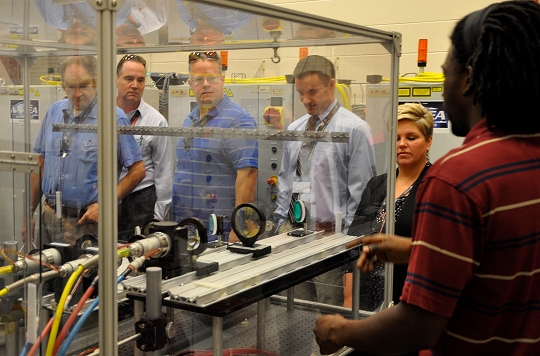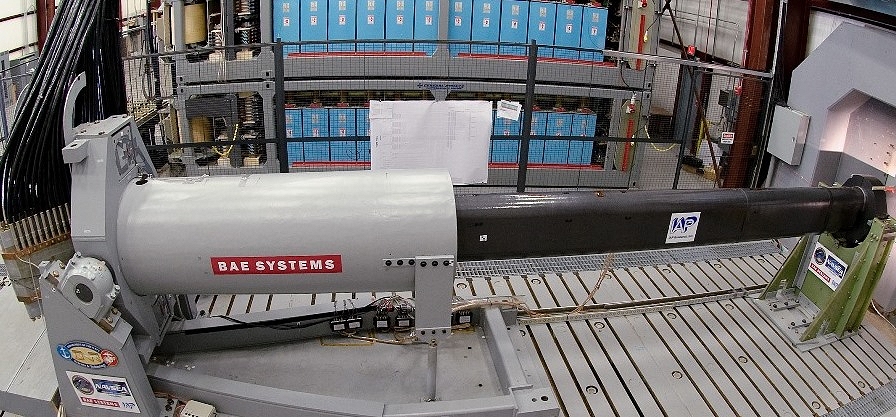 DAHLGREN, Va. - Navy aerospace engineer Roger Campbell (right) briefs Electromagnetic Maneuver Warfare (EMW) Systems Engineering and Acquisition Conference attendees on the high energy laser lethality lab, Sept. 22. The Naval Surface Warfare Center Dahlgren Division (NSWCDD) laser lethality lab has 44 kilowatt laser capability for vulnerability testing and an indoor 100 meter laser tunnel. NSWCDD co-hosted the conference in partnership with the Association of Old Crows. More than 200 attendees - including experts from the Department of Defense, private industry, military and academia - were engaged in discussions covering defense acquisition, mission engineering, electromagnetic maneuver, and electronic warfare systems. (U.S. Navy photo by Luefras Robinson/Released)
DAHLGREN, Va. - Navy aerospace engineer Roger Campbell (right) briefs Electromagnetic Maneuver Warfare (EMW) Systems Engineering and Acquisition Conference attendees on the high energy laser lethality lab, Sept. 22. The Naval Surface Warfare Center Dahlgren Division (NSWCDD) laser lethality lab has 44 kilowatt laser capability for vulnerability testing and an indoor 100 meter laser tunnel. NSWCDD co-hosted the conference in partnership with the Association of Old Crows. More than 200 attendees - including experts from the Department of Defense, private industry, military and academia - were engaged in discussions covering defense acquisition, mission engineering, electromagnetic maneuver, and electronic warfare systems. (U.S. Navy photo by Luefras Robinson/Released)DAHLGREN, Va. (Sept. 29, 2016)—Naval Surface Warfare Center Dahlgren Division (NSWCDD) co-hosted the Electromagnetic Maneuver Warfare (EMW) Systems Engineering and Acquisition Conference in partnership with the Association of Old Crows at the University of Mary Washington's Dahlgren Campus, Sept. 20-22.
The event provided a collaborative environment for discussions on the challenges associated with EMW, and the capabilities being developed to address the needs of this critical warfighting approach.
"This conference provides an excellent opportunity to learn and more importantly, to discuss operational challenges," said Capt. Brian Durant, NSWCDD commanding officer as he welcomed the standing-room-only crowd. "It's meant to help highlight the great work being done in the field, and to enable conversations to propel this capability forward."
More than 200 attendees, including experts from the Department of Defense (DoD), private industry, military and academia, were engaged in discussions covering defense acquisition, mission engineering, electromagnetic maneuver, and electronic warfare systems.
The Association of Old Crows is an international organization with interests in Electronic Warfare, Electromagnetic Spectrum Management Operations, Cyber Electromagnetic Activities, and Information Operations.
Rob Wittman, U.S. Representative for Virginia's 1st District, was the keynote speaker.
"The security environment today is as challenging as it has ever been," said Wittman. "We see many challenges well and above what we have seen in recent history, and my concern is—how do we make sure we meet those challenges?"
Wittman emphasized that the crux of this challenge is to ensure that the U.S. continues to maintain its significant advantage in the field that the country has traditionally enjoyed.
The congressman, who chairs the House Readiness Subcommittee, also expressed concern about the amount of resources being put towards readiness in the National Defense Authorization Act.
He acknowledged the dedication of the groups in the field and stressed the importance of redirecting or redesigning existing tools that are in the national arsenal to make them more effective and reach farther.
Moreover, Wittman spoke to the gathering about the funding language in the NDAA as it relates to Electronic Warfare programs. He stated that the emphasis is on doing everything they can—to not only maintain the technology, but to advance it as well.
The subcommittee tasked the Undersecretary of Defense for Acquisition Technology and Logistics with submitting a report to both the House and Senate Congressional Defense committees summarizing current capabilities of DoD Electronic Warfare, and outlining where they believe the challenges will be in the future, and what future program elements the direction must include.
"We want to make sure that they have a strategy for accelerating research, development, test and evaluation, and for fielding Electronic Warfare systems as quickly as we can," said Wittman. "The question is—how do we get technology for the warfighter more quickly?"
Deputy Assistant Secretary of the Navy for Research, Development, Test and Evaluation, Dr. John Burrow, followed up with opening remarks that expanded on the importance of collaboration within the various departments to further innovation within the field of Electromagnetic Warfare Systems.
The attendees saw the results of these collaborative efforts during their tour of NSWC Dahlgren Division. They witnessed the capabilities of the Navy's electromagnetic launch facility, including the pulsed power systems and the electromagnetic railgun. The Old Crows received briefings on directed energy and observed a Real Time Spectrum Operations equipment demonstration. They were also briefed during visits to the Electronic Warfare Integration Facility, the anechoic chamber, and the Potomac River Test Range gun line.
The three-day event featured a wide range of discussion topics presented by Electromagnetic and Sensor Systems experts. Budgeting and other challenges as well as briefings on new technology developments to enable the EMW warfighting approach were also discussed.



